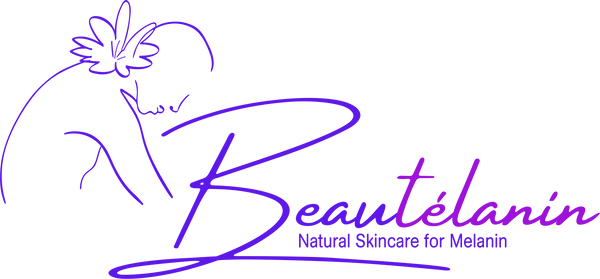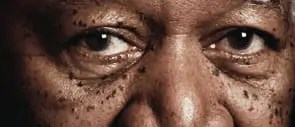
I have an aunt whose face is almost covered with Dermatosis Papulosa Nigra lesions (also known as DPN). Many of us call them “facial moles.” This skin condition appears to be hereditary. Most women in my family have these little moles on their faces and necks. I was born with a little black dot on the left side of my neck. It resembles a butterfly. The butterfly is made of several tiny little moles that have multiplied over the years. Honestly, I’ve always found my little butterfly to be aesthetically pleasing. It looks like a small tattoo. When I turned twenty-five, I began seeing multiple lesions on my face.
My mother also has her fair share of those little lesions on her face. Unlike me, she finds them aesthetically unappealing. She has tried several skincare products sold in the mainstream to get rid of them. Unsurprisingly, her efforts have not been successful. She remains very self-conscious about them. My mom is so bothered by these lesions, she encouraged me to find to start my formulating journey in the hope I would design a formula that would assist in slowing down the growth of these lesions.
Unfortunately, very few studies have been done about these lesions that seem to plague only people of color. Until recently, I didn’t know the medical term for these lesions. I did not know the right medical terminology for those skin lesions. After I decided to obtain my organic cosmetic certificate, I started researching these lesions known as Dermatosis Papulosa Nigra (DPN). So what exactly is Dermatosis Paulosa Nigra?
Dermatosis is very Common in People of Color
According to studies, Dermatosis Papulosa Nigra (DPN) is a skin condition characterized by pigmented sessile and pedunculated papule on the body, especially on the face and the neck areas. Between 10%-30% of people of African descent suffer from DPN. DPN affects women almost twice as frequently as men.
The DPN lesions are often 1 to 5 mm in size, appearing as multiple brown to dark-brown. The lesions are often asymptomatic, but occasionally they may become pruritic or become irritated. These lesions are benign with no malignant potential; however, you should consult with a physician if you have any health-related concerns about the appearance of DPN on your face or neck.
The etiology remains unknown at this time; however, there is a strong genetic predisposition for DPN as multiple family members tend to be affected by this skin condition.
There is no known Cure for Dermatosis Papulosa Nigra
The only way to get rid of DPN is through surgical intervention. Those procedures include Scissor excision, electrodesiccation, curettage, microdermabrasion, laser removal, or cryosurgery. However, none of those procedures are without their own set of complications and concerns. In a recent study, approximately fifty (50) participants took part in that study: 60% of the participants indicated they were concerned that these procedures would be very painful; 75% of the participants expressed concerns with the possibility of developing hyperpigmentation; 75% of the participants also expressed concerns that their DPN would eventually re-grow after their removal surgically.
Many of the participants expressed concerns about the surgical procedures that are available to combat DPN. Despite this, those participants were willing to remove these lesions surgical as they tend to feel embarrassed and self-conscious.
As our philosophy is about simplicity, self-love, and self-acceptance, our goal is to design formulations that can assist in slowing down the growth of DPN, and thus, allowing the skin to mature beautifully. To do this, I went back to my Haitian root. For as long as I can remember, my mom watches her face with an herb called Asosi in Creole (Bitter Melon). In Haitian culture, you can cure anything with Asosi.
While researching the roots and causes of DPN, I came across an old Indian traditional medicine practice called Ayurvedic. Ayurvedic is also known as Ayurveda is one of the world’s oldest holistic approaches to healing. It has been in practice for more than 3,000 years. This traditional medicine is based on the belief that health and wellness depend on a balance between the mind, body, and spirit. The Indian holistic approach fits our philosophy perfectly here at Aging Beautified.
The principal tenet of Ayurvedic medicine is to prevent and treat illness rather than respond to the disease by maintaining a balance between the body, mind, and environment. Here at Aging Beautified, our products are a mixture of Haitian herbs and Ayuverdic herbs and oils.
Our products contain ingredients such as Haitian Asosi (Bi, Haitian castor oil, Indian Gooseberry (Amla), Ashwagandha, Bibhitaki (Terminalia Bellirica), Bhrami (Bacopa Monieri), Haritaki (Terminalia Chebula), Indian frankincense, Gotu Kola. Studies have suggested these herbs and oils are riched with antioxidants, meaning they are capable of neutralizing free radicals that cause long-term harm to the cells in our bodies. Since DPN lesions are nonmalignant cell growth, the antioxidants, anti-inflammatory, antimicrobial-rich ingredients may assist in slowing down the grown of these unaesthetic lesions.
References
Dermatosis Papulosa Nigra: A quality of Life Survey Study, Lara N. Uwakwe, MD, Brianna DE Souza, MD, […] and Amy J. McMichael, MD.
Kundu RV, Patterson S. (2013). Dermatologic Conditions in Skin of color: Part II. Disorders occurring predominately in the skin of color. American Family Physician, 87 (12), 859-865.
Gregory H. Lisa. Ayuverdic Herbs: The Comprehensive Resource to Natural Healing ith Ayuverdic Herbalism.
Lee Sara, BA amd Kindu V. Roopal, MD. Dermatosis Paulosa Nigra (DPN). www.Skinofcolorsociety.org

